1. Introduction to Caustic Soda Usage in Middle Eastern Countries
The usage of caustic soda, also known as sodium hydroxide (NaOH), plays a significant role in various industries across Middle Eastern countries. Caustic soda is a versatile chemical compound utilized in sectors such as petrochemicals, textiles, pulp and paper, water treatment, and many more. With the growing importance of caustic soda in industrial processes, it becomes essential to understand the regulatory frameworks and standards governing its production, handling, and usage in the Middle East. This article provides an overview of the regulatory landscape, highlighting the key regulations, standards, safety measures, and environmental considerations associated with caustic soda usage in Middle Eastern countries. Furthermore, it explores regional variations in regulatory approaches and discusses future trends and challenges in effectively regulating caustic soda usage in the Middle East.
1. Introduction to Caustic Soda Usage in Middle Eastern Countries
Caustic soda, also known as sodium hydroxide, plays a vital role in various industries across the Middle East. From manufacturing textiles to producing paper, this versatile chemical is indispensable. Caustic soda is primarily used for its corrosive and alkaline properties, making it an essential ingredient in the production of detergents, soaps, and cleaners.
1.1 Importance of Caustic Soda in Various Industries
Caustic soda is a key ingredient in the production of textiles, paper, and pulp, as well as in the manufacturing of aluminum, petroleum products, and chemicals. It is used for pH regulation, neutralization, cleaning, and saponification processes. Without caustic soda, these industries would face significant challenges in meeting their production needs.
1.2 Overview of Caustic Soda Production and Consumption in the Middle East
The Middle East is a major player in the caustic soda industry, both as a producer and consumer. Countries like Saudi Arabia, the United Arab Emirates, and Qatar have heavily invested in caustic soda production facilities. These countries take advantage of their natural resources, such as salt and natural gas, to produce significant quantities of caustic soda for domestic and export markets.
2. Overview of Regulatory Frameworks for Caustic Soda
Regulatory frameworks and standards play a crucial role in ensuring the safe and responsible usage of caustic soda in Middle Eastern countries. Government agencies and regulatory bodies are actively involved in formulating legislation, regulations, and policies to protect human health, safety, and the environment.
2.1 Roles of Government Agencies and Regulatory Bodies
In Middle Eastern countries, government agencies and regulatory bodies such as the Ministry of Industry, Ministry of Health, and Environmental Protection Agencies oversee caustic soda usage. They are responsible for issuing permits, conducting inspections, and enforcing compliance with regulations.
2.2 Legislative Framework for Caustic Soda Usage
Middle Eastern countries have developed legislative frameworks to regulate the production, import/export, storage, and handling of caustic soda. These laws ensure that companies follow safety protocols and adhere to environmental standards.
2.3 Key Regulations and Policies for Caustic Soda in the Middle East
Specific regulations and policies aim to safeguard workers, communities, and the environment from the potential hazards associated with caustic soda. These include guidelines for occupational health and safety, labeling requirements, emergency response plans, and waste management procedures.
3. Standards and Guidelines for Caustic Soda Handling and Storage
To ensure safe handling and storage practices, international standards and guidelines for caustic soda manufacturing have been established. These standards outline protocols for manufacturing processes, equipment, transportation, and emergency response.
3.1 International Standards for Caustic Soda Manufacturing
International organizations like the International Organization for Standardization (ISO) and the American Society for Testing and Materials (ASTM) have developed standards for caustic soda manufacturing. These standards cover quality control, safety measures, and the handling of hazardous materials.
3.2 Storage and Transportation Guidelines for Caustic Soda
Guidelines for the safe storage and transportation of caustic soda are essential to prevent accidents and ensure the integrity of the chemical. These guidelines address factors such as appropriate storage containers, ventilation requirements, and compatibility with other chemicals during transportation.
3.3 Handling and Personal Protective Equipment (PPE) Standards
Given the corrosive and hazardous nature of caustic soda, proper handling and the use of personal protective equipment (PPE) are crucial. Standards for handling techniques and recommended PPE, such as gloves, goggles, and protective clothing, help protect workers from potential injuries or exposure.
4. Environmental Regulations and Impact on Caustic Soda Usage
The production and usage of caustic soda can have environmental impacts, which necessitate strict regulations to minimize harm. Environmental regulations focus on controlling emissions, waste management, and conducting environmental impact assessments.
4.1 Environmental Concerns Associated with Caustic Soda Production and Usage
Caustic soda production and usage can contribute to environmental concerns such as air pollution, water contamination, and waste generation. These concerns highlight the importance of implementing effective environmental regulations and monitoring systems.
4.2 Emission Control and Waste Management Regulations
To mitigate the environmental impact, strict regulations are in place to control emissions from caustic soda production facilities. Waste management regulations ensure proper disposal and treatment of by-products and residues, minimizing their impact on ecosystems and human health.
4.3 Environmental Impact Assessments for Caustic Soda Facilities
Before the establishment or expansion of caustic soda facilities, environmental impact assessments are conducted to evaluate the potential consequences on the surrounding environment. These assessments help identify and address any potential risks or ecological disruptions, ensuring sustainable development practices.
5. Safety Measures and Best Practices in Caustic Soda Manufacturing and Handling
5.1 Occupational Health and Safety Regulations
When it comes to caustic soda manufacturing and handling, safety should always be a top priority. Occupational health and safety regulations play a crucial role in ensuring the well-being of workers in this industry. These regulations typically cover areas such as proper handling procedures, personal protective equipment (PPE) requirements, and emergency response protocols. By complying with these regulations, companies can create a safer working environment for their employees and minimize the risk of accidents or injuries.
5.2 Risk Assessment and Management in Caustic Soda Facilities
Identifying and managing potential risks is essential in any caustic soda facility. This involves conducting thorough risk assessments to identify potential hazards, evaluating the probability and severity of accidents, and implementing appropriate risk management measures. These measures may include installing safety equipment, implementing containment measures, and establishing emergency response plans. By proactively addressing risks, companies can reduce the likelihood of accidents and ensure the safety of both their employees and the surrounding environment.
5.3 Training Programs and Safety Culture in the Industry
Creating a strong safety culture is vital for the caustic soda industry. This involves providing comprehensive training programs for employees, ensuring they are equipped with the knowledge and skills to work safely. Training should cover topics such as proper handling techniques, emergency procedures, and the use of protective equipment. Additionally, fostering a culture of safety means encouraging open communication, reporting of near misses, and continuous improvement. By prioritizing safety and investing in training programs, companies can create a work environment where safety is ingrained in every employee’s mindset.
6. Regulatory Compliance and Enforcement in Middle Eastern Countries
6.1 Monitoring and Inspection of Caustic Soda Facilities
To ensure regulatory compliance, Middle Eastern countries conduct regular monitoring and inspections of caustic soda facilities. These inspections typically assess various aspects, such as equipment integrity, safety measures in place, adherence to regulatory standards, and environmental impact. By conducting thorough inspections, regulatory authorities can identify any potential gaps or violations and take appropriate actions to rectify them.
6.2 Penalties and Consequences for Non-Compliance
Non-compliance with regulatory standards can result in significant penalties and consequences for companies operating in the caustic soda industry. These penalties may include fines, suspension of operations, or even legal action. The severity of the consequences depends on the nature and extent of the violation. By strictly enforcing penalties, regulatory authorities send a clear message about the importance of following regulations and ensure that companies prioritize compliance.
6.3 Collaboration between Regulatory Authorities and Industry Stakeholders
Collaboration between regulatory authorities and industry stakeholders is essential for effective regulatory compliance and enforcement. By working together, these parties can share knowledge, exchange best practices, and address any challenges or concerns that arise. Industry stakeholders, such as associations and companies, can provide valuable insights into the practicalities of compliance, while regulatory authorities can offer guidance and support. This collaboration ultimately leads to a more robust regulatory framework and a safer working environment in the caustic soda industry.
7. Regional Variations in Regulatory Approaches to Caustic Soda Usage
7.1 Country-specific Regulatory Differences and Similarities
While there are overarching regulatory frameworks for caustic soda usage in the Middle East, each country may have specific regulations tailored to their unique circumstances. These differences can be influenced by factors such as local industry size, environmental concerns, and government priorities. However, despite these variations, there are often similarities in the fundamental principles and objectives of the regulations across the region. Understanding these differences and similarities is crucial for companies operating in multiple Middle Eastern countries.
7.2 Case Studies of Regulatory Implementation in Select Middle Eastern Countries
To gain a deeper understanding of how regulatory frameworks are implemented, it is helpful to examine case studies of specific Middle Eastern countries. These case studies can highlight the practical application of regulations, challenges faced, and lessons learned. By analyzing these examples, companies can gain insights into successful strategies for regulatory compliance and learn from the experiences of others in the industry.
In conclusion, the regulatory frameworks and standards for caustic soda usage in Middle Eastern countries play a crucial role in ensuring the safe and responsible handling of this chemical compound. By adhering to these regulations, industries can mitigate environmental impacts, protect the health and safety of workers, and maintain the quality of products and processes. However, as the industry continues to evolve, it is imperative for regulatory authorities and industry stakeholders to collaborate and adapt to emerging challenges. By staying updated with the latest regulations and implementing best practices, Middle Eastern countries can ensure the sustainable and efficient use of caustic soda in the years to come.
FAQ
1. What industries in the Middle East rely on caustic soda?
Caustic soda is widely used in various industries in the Middle East, including petrochemicals, textiles, pulp and paper, water treatment, soap and detergent manufacturing, and aluminum production, to name a few. Its versatility makes it an essential component in numerous industrial processes.
2. What are some key environmental considerations related to caustic soda usage?
Caustic soda usage can have environmental impacts, such as the potential for water pollution, air emissions, and waste generation. Environmental regulations focus on controlling and minimizing these impacts through measures like emission control, waste management, and the requirement of environmental impact assessments for caustic soda facilities.
3. What safety measures should be followed when handling caustic soda?
When handling caustic soda, it is crucial to follow safety measures such as wearing appropriate personal protective equipment (PPE), ensuring proper storage and transportation, conducting risk assessments, and implementing comprehensive training programs for workers. These measures help mitigate the risks associated with caustic soda and promote a safe working environment.
4. Are there variations in regulatory approaches among Middle Eastern countries?
Yes, there can be variations in regulatory approaches to caustic soda usage among Middle Eastern countries. While some regulations might be similar, there can be differences in specific requirements, enforcement mechanisms, and monitoring procedures. Understanding these regional variations is crucial for businesses operating in multiple countries to ensure compliance with local regulations.









